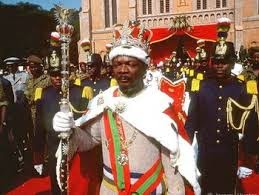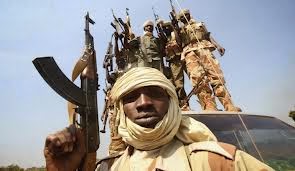The Central African Republic (C.A.R.) may be about to become a bit more decentralized. Since 2012, members of the Christian and tribal majority in the center and south and the northern Muslim minority have engaged in a bloody civil war. The mostly-Muslim rebel coalition Séléka took power in the capital, Bangui, in a March 2013 coup d’état but was forced out of office in January of this year. Now, Séléka leaders are saying that they think a separate state is the only way to avoid escalating ethnic cleansing or even genocide. Some, indeed, are already using the term genocide to refer to reprisals by Christians against Muslim civilians—including highly-publicized but not fully verified accounts of Christian-on-Muslim cannibalism. As one Muslim leader put it recently, “The partition itself has already been done. Now there only remains the declaration of independence.”
Naturally, the African Union, the United Nations, and other international organizations scrambling to contain the C.A.R. violence are against the idea: only one fully new border has been drawn since African decolonization beginning in the 1960s decided to leave unmodified the patchwork of European-drawn lines that paid no attention to where cultural, linguistic, and religious groups actually lived. The one exception is the Republic of South Sudan, which the United States and U.N. ushered through a referendum process and secession in 2011, separating the mostly-Christian and spiritually traditional nation from its Muslim former rulers in the rump Republic of Sudan. But South Sudan has since then descended into a fratricidal civil war that has also tipped close to something worthy of the term genocide. The former Sudan and C.A.R. are only two out of a string of African states straddling the volatile boundary between Africa’s Muslim (often Arab) north and a sub-Saharan area that is less Arabized and more often Christian, including Mali, Nigeria, Côte d’Ivoire (Ivory Coast), Chad, and Cameroon, all of which to different extents have seen horrific sectarian violence along that divide. Mali came closest to disintegrating with the creation of the brief-lived radical-Islamist northern Republic of Azawad, finally shut down last year by France’s military.
 |
| The viral-video sensation “Mad Dog” (standing), the reputed “Muslim-eater” of the recent sectarian conflict in the Central African Republic |
 |
| The C.A.R.'s Muslims are concentrated primarily in the far north. |
 |
| Spot the difference! The flags of Sudan (top) and South Sudan (bottom) |
 |
| Emperor Bokassa I on his way to have the Belgian ambassador for dinner |
A reporter this week quoted one Muslim Séléka-supporter, Oumar Tidiane, as saying, of the C.A.R.’s Christian southerners, “They don’t want any Muslims. Rather than calling their country the Central African Republic, they can call it”—ahem, get this—“the Central African Catholic Republic.” Good God, when they send the next aid shipment, can they please airdrop a team of marketing experts? It’s time for a lesson on branding.
As for the chances of the success of the Republic of Northern Central Africa, they are slim. In addition to the problem of international opposition is the question of demographics. One consultant in the region, David Smith, suggested to the Guardian newspaper that the impetus for partition was coming mostly from foreign fighters from predominantly-Muslim states like Chad and (north) Sudan, rather than from Centrafriquain people themselvess. Besides, he pointed out, the already small Muslim share of the C.A.R. before the current conflict, between 10% and 15%, has shrunk dramatically, due to ethnic cleansing, emigration of refugees, and outright massacres: tens of thousands have been killed and a million displaced, this in a country with fewer than 5 million people total to begin with. As in places like Bosnia, Tibet, and Palestine, the dominant, more aggressive group has changed the demographic facts on the ground, making earlier goals less and less feasible by the day. If for that reason alone, a separate R.N.C.A.—or whatever—is a pipe dream. But if this movement goes down in flames, they should least pick a punchier name. And when I finally see that flag, I don’t want another tricolor, okay?
 |
| In French colonial days, Oubangui-Chari (now the C.A.R.) was Kentucky-shaped. |
[You can read more about many other separatist and new-nation movements, both famous and obscure, in my new book, a sort of encyclopedic atlas just published by Litwin Books under the title Let’s Split! A Complete Guide to Separatist Movements and Aspirant Nations, from Abkhazia to Zanzibar. The book, which contains 46 maps and 554 flags (or, more accurately, 554 flag images), is available for order now on Amazon. Meanwhile, please “like” the book (even if you haven’t read it yet) on Facebook and see this interview for more information on the book.]







The map you present identifying ethnic groups in is actually Burkina Faso. The shapes of both countries are somewhat similar. Tim Egan (Jane's husband and former PCV in C.A.R.)
ReplyDeletethe map is not central africa but brkina/fasso...
ReplyDeleteits a shame the behaviour of france, putting and removing goverments in that unfortunate country, while people is dying during months! caotic!!!
BABAEL
Thanks, Tim! Egg on my face ... I've now fixed it.
ReplyDeletei wonder if seleka men are less violent than antibalakas...
ReplyDeleteBABEL
i hope soon we know that northern flag...
The CAR-flag isn't exactly tricolor
ReplyDeleteI assure you, this is the map of the Central African Republic. It resembles that of Burkina Faso,. It looks almost. I am Central African, and I recognize the map of my country. Thank you to view maps of these countries, you will notice a resemblance.
ReplyDelete